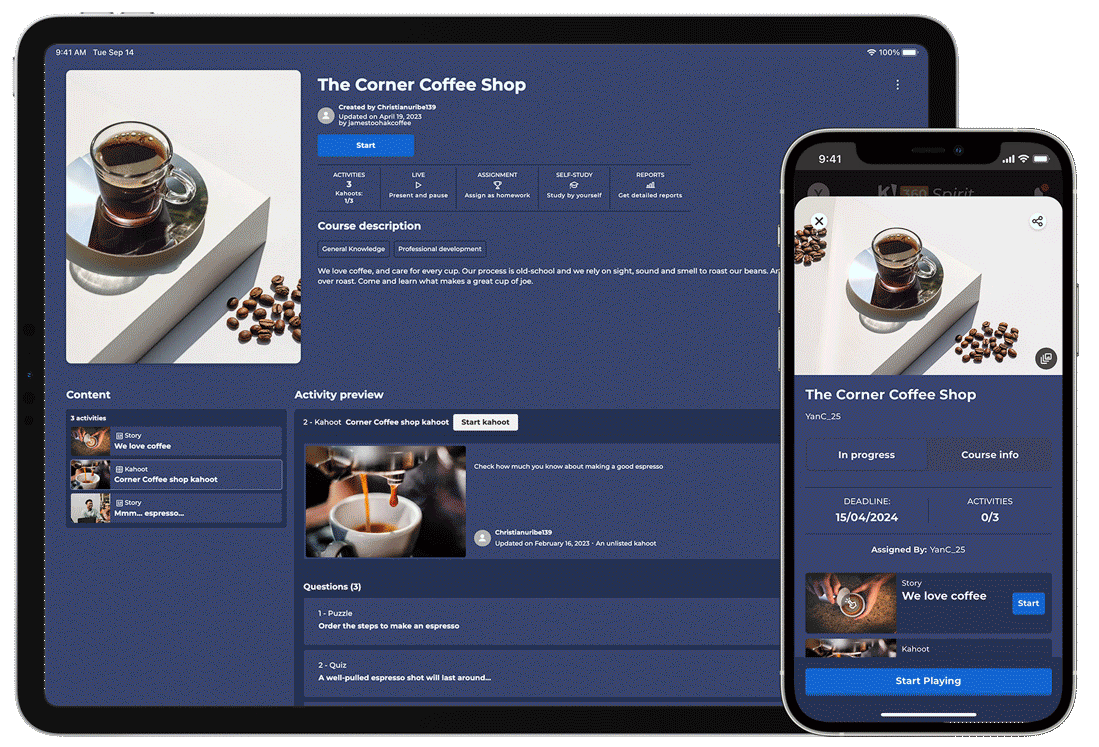Flexible work has redefined where, when, and how we work, but it’s also creating new challenges and opportunities for how employees can learn and grow their skills. Some trainers and business leaders worry that hybrid or virtual training will be less engaging, and the risk is real: a Kahoot! Workplace Culture Report showed that virtual training is the #1 place people report mentally tuning out.
However, many companies actually see a boost in engagement when they adopt flexible, tech-enabled L&D strategies. Why? Because these companies do not simply use video conferencing to deliver the same traditional lectures—which were likely not very engaging in-person either. Instead, they’re optimizing for hybrid or virtual experiences, taking advantage of new opportunities through technology to create training that’s more dynamic and engaging than ever.
How can organizations learn from these successes and optimize training for flexible work? Start by considering these key strategies:
1. Beat the clock with microlearning
Time constraints are the #1 barrier to upskilling, according to a recent Kahoot! research report. While employees recognize the importance of upskilling—as 46% worry their skills will be obsolete within 5 years—many feel they simply don’t have the time.
Microlearning—such as with Kahoot! courses—can be a powerful tool in relieving time pressures while actually increasing knowledge learned over time. To get started, try splitting up larger courses into smaller, bite-sized chunks that can be deployed when most relevant, enabling employees to apply their learning right away and make it stick. This approach can also help boost completion rates. In research from Software Advice, nearly 60% of employees say they would be more likely to take advantage of their organization’s digital learning offerings if the material was split into shorter lessons.
Through microlearning, which employees can complete anywhere and at their own pace, companies can avoid overwhelming employees with information and long time commitments. Instead, companies can start a steady drip of training that gradually establishes a culture of continuous learning.

2. Use technology to create more human-centric learning
It may seem counterintuitive, but when designed right, tech-integrated training can be more effective at fostering human connection, compared to traditional lecture training. With technology, you can easily transform training from an infodump to an interactive experience that invites active participation through questions, friendly competition, or collaboration. This may be particularly key for engaging young employees, who name interactivity as a solution to video call fatigue, and friendly competition as their top choice to add more engagement to virtual trainings, meetings, and presentations.
By encouraging participants to take a more active role, learning can also become a time for employees to bond across teams and geographies. As per LinkedIn’s 2024 Workplace Learning Report, 7 in 10 employees report that learning gives them a greater sense of connection to their company. This underscores the important role learning could play in helping distributed teams stay connected to each other and engaged in their work.
For example, AND Digital—a company working to end the world’s digital skills gap—developed a scalable hybrid onboarding and learning experience for over 1600 employees internationally. This not only impacted training, but sent ripple effects through their company culture.
Toni Morgans, L&D Consultant at AND Academy, shared how, “Kahoot! helps us uncover personal stories, roles, and connections among team members, enhancing our culture of embracing individuality at work. This social aspect strengthens our business’s culture and boosts job satisfaction, proving the significance of incorporating this social element.”

3. Track progress with data and celebrate learning wins
For any organization trying to drive change, externally or internally, clear data to track their strategy’s results is essential. However, when companies only train with in-person lectures, trainers may not be able to gather any data on employees’ understanding of the training concepts, or even attendance. This also makes it difficult to recognize employees’ upskilling efforts, which 90% of employees say would boost their motivation to learn.
Instead, experiment with learning technologies like Kahoot! that enable trainers to measure the effectiveness of the training. For example, quiz questions can help gauge understanding of specific concepts, and completion rates can indicate overall engagement. These technologies can also provide built-in recognition or rewards for employees during the learning experience, such as leaderboards or winner podiums visible to all employees. With data, trainers can address learning gaps and refine their instruction to improve engagement and ultimately learning outcomes.
Global customer experience technology and services company TTEC followed this strategy by replacing traditional instructor-led facilitation with virtual training, which was designed to be learner-centric, hands-on, and engaging. By weaving interactive elements throughout training, they were able to not only keep employees engaged, but track their learning and ensure the information stuck. Miguel “Iggy” Buenavista, Learning & Development Manager at TTEC, revealed that this approach of leveraging learning science and engaging interactivity with Kahoot!, “…led to a 53% higher overall NPS in training, 36.7% lower attrition during the training period, and 10.5% higher trainer NPS.”
Track employees’ learning progress with Kahoot!’s detailed reports and celebrate their achievements with course certificates and more, available in Kahoot!’s new training toolkit!

Redefining the future of training
The future of flexible work opens new possibilities for companies to be agile and adaptable, and employee learning will need to adapt alongside it. By designing flexible learning strategies that resonate with modern professionals and leverage the capabilities of technology, companies can not only support their employees to thrive through continuous growth, but also deliver real business impact.
Get started creating future-ready training at your organization with Kahoot! 360!
This blog post is based on an article originally published in Training Industry.




